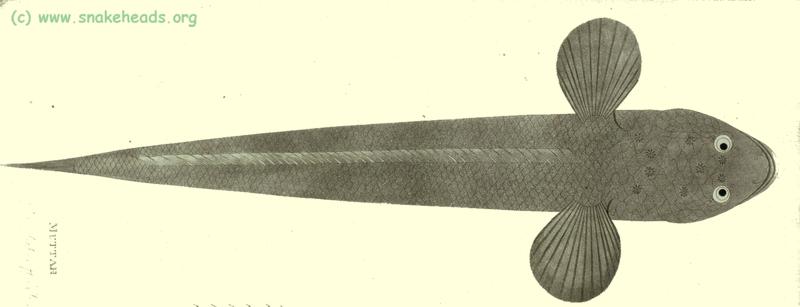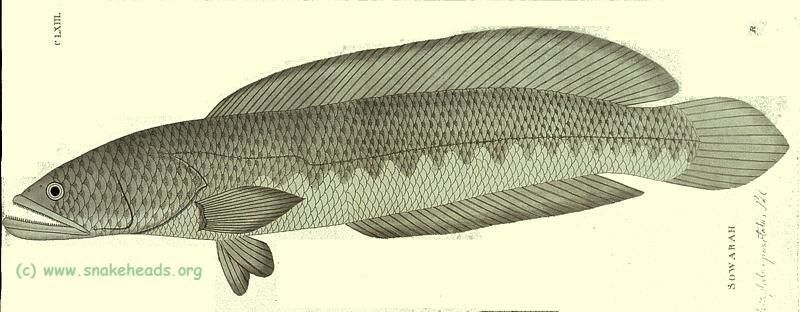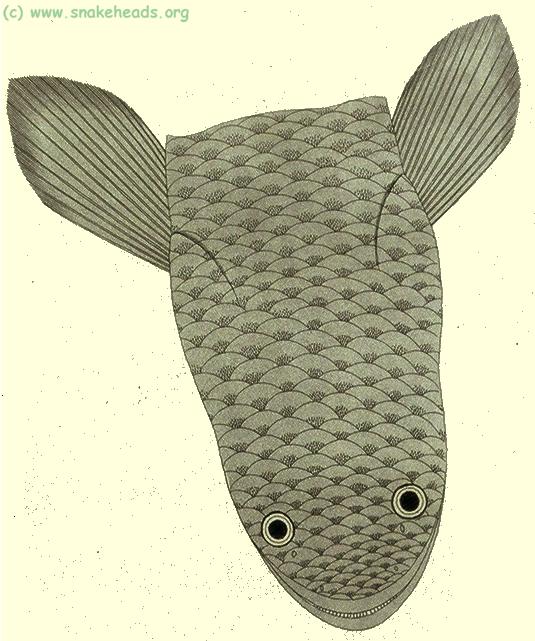
[ ... ]
Caput depressum, squamis variis . Bloch
The head depressed, with scales of an unusual and different shape from those on the body.
Ophicephalus corpore lanceolota, squamoso, lubrico; linea lateralis infracta; pinnis pectoralibus caudaque rotundatis.
The Ophicephalus with a lanceolate, squamous, lubricous, body; the lateral line infracted; the pectoral and caudal fin rounded.
Ophicephalus striatus Bloch . Part x [vii; snakeheads.org] . p. 117, Tab. 359.
Called by the Natives «Muttah»
B. v. D. 45. P. 15. V. 6. A. 1/26. C. 14.
 | Plate 162: C. striata by R. Russel |
The body lanceolate, roundish, compressed, squamos, lubricous. The scales on the head very differnt in from those on the body.
The head broader than the body, depressed, hardly declivious, covered with remarkably large, bony, angular scales, contiguous, not imbricate; the rostrum naked. The mouth wide, horizontal, rounded, lips thin; jaws extractile, the under somewhat longer. The fore teeth above and below, in several rows, close and small; in the under jaw behind are some larger curve teeth. The tongue short, sharp, smooth, free. On each side of the palate a phalanx of small teeth. The eyes supreme, near the rostrum, small, round, the iris orange, the obit deep. Nostrils double; raund; one close to the orbit, the other on the verge of the rostrum; neat the latter a small tubulus, hardly visible in the dead subject. The branchial opercula oblong, squamous, the posterior margin ciliate; the membrane exposed; the aperture arched, lateral and gular.
 | Plate 162: C. striata by R. Russel, topview. |
The trunk . The back almost straight, declining very gently towards the tail. The abdomen straight, convex; the sides rounded at the shoulders, more compressed towards the tail. The branchiae tuberculate, and rough. The lateral line conspicuous, not carinate; slops gently grom the upper edge of the opercula till on a line with the eleventh ray of the dorsal fin, then bends abruptly, and runs straight along the middle of the tail. The anus nearer the head than the caudal fin.
The colour of the head and back very dark, or nearly black; approaching the lateral line it grows a few shades lighter, and, extending over it, forms a row of oblong-conical marks pointing downwards, the interstices between which are nearly of the same colour with the abdomen and under part of the tail, viz. a dull reddish-white. The fins not so black as the back; the ventral alone are light coloured.
The length of the subject described, sixteen inches.
Ophicephalus corpore oblongo, squamis magnis, rotundis punctatis, linea lateralis infracta; pinnis pectoralibus caudaeque rotundatis cum acumine.
The Ophicephalus with an oblong body, large, rounded,, dotted scales; the lateral line infracted; the pectoral fins, and the caudal round, with a small point.
Ophicephalus punctatus Bloch . Part x [vii; snakeheads.org] . p. 117, Tab. 358.
Called by the Natives «Sowara»
B. v. D. 45. P. 17. V. 6. A. 26. C. 14.
 | Plate 173: C. punctata by R. Russel, side view. |
The body . This fish in shape differs from the last. It is rather oblong than lanceolate, rounder at the shoulder, more compressed near the tail, an dbend from the anus gently upward to the end of the anal fin. The scales are larger, orbicular, and all, except on the abdomen, marked with a cluster of small black dots on the anterior part. The body, as in the former fish, lubricous.
The head . There is little difference in the shape of the head; but the scales on the crown are here only larger than those on the trunk, of the same form, and imbricate. The marginal row of teeth more complete. The tubuli on the edge of the rostrum less conspicuous. The mouth, tongue, palate, eyes, nostrils, and branchial membrane; the branchiae, lateral line, and position of the anus, as already described in the Muttah .
 | Plate 173: C. punctata by R. Russel, topview. |
The first lamina of he operculum obtusely angular, the second acuminate.
The fins . The dorsal and anal are alike in both fish, except the want of a spine in the latter fin; the pectoral fin and caudal are pointed as well as round; the ventral more obtuse, and proportionally longer.
The colour less dusky, with an obscure tinge of green. A regular row of angular marks, of a colour lighter than that of the back, formms a denticulate border to the lateral line, from its infraction to its end. Beneath these the colour is a yellowish white. The dorsal, anal, and caudal fins, with a greenish cast, are less dusky than the back; the pectoral and ventral of a yellowish dusky white.
The length , one foot six inches.
This fish was brought in the month of July, in a jar of water, from the lake of Ankopilly, and lived several days. They survive many hours even out of water.
Ophicephalus corpore lanceolata, purpurascente; pinnis pectoralibus radiis duodecem, striatis.
The Ophicephalus with a lanceolate, purplish body; a pectoral fin of twelve rays, striated transveresly.
Called by the Natives «Kora Motta»
B. v. D. 36. P. 12. V. 5. A. 23. C. 14.
This fish has only twelve rays in the pectoral fin, and five in the ventral. In most of the other characters it agrees with the Mutta, No. CLXII. than with the one last described .
In colour it differed from both. The back a cast of dusky purple, the breast bluish, the abdomen dark gray.
The dorsal and part of the anal fin of the same colour as the body; the hinder portion of the dorsal a dark orange; the pectoral streaked traversly black and yellow; the points of the caudal rays distinctly separate, and tipped yellow.
The length . of the subject, six inches.
None of this genus were ever caught in the sea or in the river. I found them in the lake of Ankapilly and Casem Cottah, as also in a tank close to Vizagapatam.
It has been already remarked that, like eels, they may be long preserved alive in fresh water.
[ ... ]
This passage was originally published in the book with the title above mentioned; vol. 2, pp. 47-49. London 1803.
| © 2001 - 2004 snakeheads.org | HOME of this page |